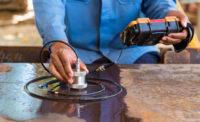NDT | Radiography
Revolutionizing Inspection with Conformable/Flexible DDA Technology
It’s a new chapter in industrial radiography.

Image Source: EXTREME-PHOTOGRAPHER / E+ / Getty Images
In the world of industrial inspection, where precision and accuracy are paramount, recent advancements in digital radiography (DR) have introduced a revolutionary technology: conformable/flexible digital detector array (DDA) panels. This breakthrough in radiographic design allows for these DDA panels to adapt to various shapes and surfaces, providing comprehensive imaging in scenarios where traditional rigid detectors fall short. For industries ranging from aerospace to construction and manufacturing, these conformable/flexible DDA panels are more than an innovation; they’re a notable change for nondestructive testing (NDT).
Understanding Conformable/Flexible DDA Technology
Traditional digital radiography has served industries well for decades, offering high-resolution images that help inspect, analyze, and verify components and structure. However, standard DDA panels are flat and rigid, making capturing detailed images of curved or irregular surfaces, such as pipelines, turbine blades, and composite structures challenging. Flexible or conformable DDAs, in contrast, use materials that can conform to the contours of these objects, yielding higher-quality images that reveal critical details with remarkable clarity.
Flexible amorphous silicon detectors are now commercially available, enabling conformable radiographic inspection, particularly for weld applications. Various ASTM standards support these developments as follows:
- ASTM E2736 This standard provides a guide for the other DDA standards (see Practices E2597, E2698, and E2737).
- ASTM E2698 establishes the basic parameters for the application and control of the digital detector array radiographic method.
- ASTM E2737 is intended to be used by the DDA user to measure and record the baseline performance of an acquired DDA to monitor its performance throughout its service as an imaging system.
- ASTM E2597 describes manufacturer-specific characterization of DDA image quality.
- ASTM 2699 defines a set of information modules that along with Practice E2339 and the DICOM standard provide a standard means to organize digital X-ray test parameters and results.
As with all digital radiographic modalities, understanding the various elements that work together to form the digital image and how each element impacts the quality of the resulting image is of the utmost importance. Elements such as appropriate pixel value, signal to noise ratio, contrast to noise ratio, integration times and frame averaging settings all contribute greatly to the final image quality.
Applications for Conformable/Flexible DDA in Industry
Conformable/flexible DDA technology is rapidly gaining traction across various industrial sectors, each finding unique applications for its advantages:
- Aerospace and Aviation: Aircraft components are often intricate, featuring complex shapes and materials that require thorough inspection. Conformable/flexible DDA technology is ideal for examining the integrity of turbine blades, fuel lines, and fuselage parts, as it allows inspectors to maneuver around these curves, capturing high-quality images without compromising safety or structural integrity.
- Oil and Gas Pipelines: Oil and gas pipelines are typically vast and difficult to inspect using conventional methods. Conformable/flexible DDA panels can conform to the pipeline’s shape, identifying corrosion, cracks, or any structural anomalies. This flexibility reduces the need for disassembly and keeps inspections non-invasive, all while ensuring safety in areas prone to high pressures and hazardous materials.
- Automotive Manufacturing: The automotive industry also benefits significantly from Conformable/flexible DDAs in inspecting components like exhaust systems, engine parts, and intricate electrical assemblies. Flexible radiography is particularly useful for assessing welds in hard-to-reach areas, ensuring the durability and safety of vehicles without time-intensive inspections.
- Construction and Infrastructure: Conformable/flexible DDAs provide critical insight into the structural integrity of construction materials, such as concrete or metal reinforcements, particularly in bridges, tunnels, and other load-bearing structures. The flexibility of the technology enables seamless imaging of otherwise inaccessible spots, which is invaluable for assessing long-term durability and pinpointing areas at risk of structural fatigue.
- Electronics and Circuit Boards: In electronics manufacturing, conformable/flexible DDAs can aid in the inspection of intricate circuit boards and components, ensuring high product quality. Flexible DDA panels conform to the compact layouts typical in electronic devices, helping identify defects, misalignments, or incomplete solder joints without risking damage to delicate circuitry.
Advancements Driving Bendable DDA Technology
The success of conformable/flexible DDA is due in large part to advancements in materials science and digital imaging. Some key developments include:
- Organic Photodetectors: They can be manufactured on lightweight, bendable substrates, allowing for higher sensitivity and adaptability in comparison to traditional rigid detectors. Their organic nature also contributes to greater cost-effectiveness, which is essential for scaling the technology in the industry.
- Flexible Thin-Film Transistors: The flexibility of these transistors makes them ideal for conformable/flexible DDAs, as they can adapt to a range of surfaces and shapes without compromising functionality.
- Improved Software for Image Processing: With this new conformable DDA, specialized software is crucial to correct any image distortion caused by the curved nature of the panels. Advances in image processing algorithms are now making it possible to produce high-resolution, undistorted images, which are essential for industrial applications requiring precision.
Challenges and Considerations
While conformable/flexible DDA technology offers numerous advantages, it is not without challenges. The development of flexible materials that can withstand the rigors of industrial environments, such as extreme temperatures or corrosive atmospheres, is still an ongoing challenge. Additionally, the cost of manufacturing flexible detectors can be higher than traditional panels, although it is expected that economies of scale will reduce prices as demand increases.
Another key consideration is the integration of this innovative technology into existing inspection protocols. Training technicians to work with conformable/flexible DDA equipment and interpret the resulting images effectively will be crucial to maximizing its benefits.
Future Prospects for conformable/flexible DDA in the Industry
The future of conformable /flexible DDAs in industrial applications looks promising, with ongoing research focused on enhancing the flexibility, durability, and affordability of these systems. As technology matures, industries may see even broader applications, potentially revolutionizing fields like underwater inspection, robotics, and automated manufacturing.
Furthermore, the potential for real-time imaging using conformable/flexible DDAs could lead to even greater efficiency. With developments in wireless data transmission and AI-driven analysis, real-time inspections could become standard practice, giving technicians immediate feedback, and enabling instant decision-making on the production floor.
Conclusion: The New Standard in Industrial Radiography
Conformable/flexible DDA technology represents a significant leap forward for industrial radiography. By offering a flexible, high-resolution imaging solution that adapts to the complex shapes and surfaces characteristic of industrial environments, conformable/flexible DDA has the potential to become the new standard in digital radiography. The improvements in inspection accuracy, efficiency, and safety of conformable/flexible DDAs make it a highly desirable technology for industries focused on maintaining high-quality standards while minimizing operational downtime.
As conformable/flexible DDAs continue to evolve, we are likely to witness its integration across an even broader range of sectors, paving the way for a future where industrial inspections are faster, safer, and more efficient than ever before. For industries that depend on reliability and precision, this rather new and exciting DDA offers an invaluable tool, promising a future where quality and innovation go hand in hand.
References
ATSM E2736, “Standard Guide for Digital Detector Array Radiography, “The American Society of Testing Materials International.
ATSM E2698, “Standard Practice for Radiographic Examination Using Digital Detector Arrays, “The American Society of Testing Materials International.
ASTM E2737, “Standard Practice for Digital Detector Array Performance Evaluation and Long-Term Stability,” The American Society of Testing Materials International.
ATSM E2597, “Standard Practice for Manufacturing Characterization of Digital Detector Arrays, “The American Society of Testing Materials International.
Looking for a reprint of this article?
From high-res PDFs to custom plaques, order your copy today!





